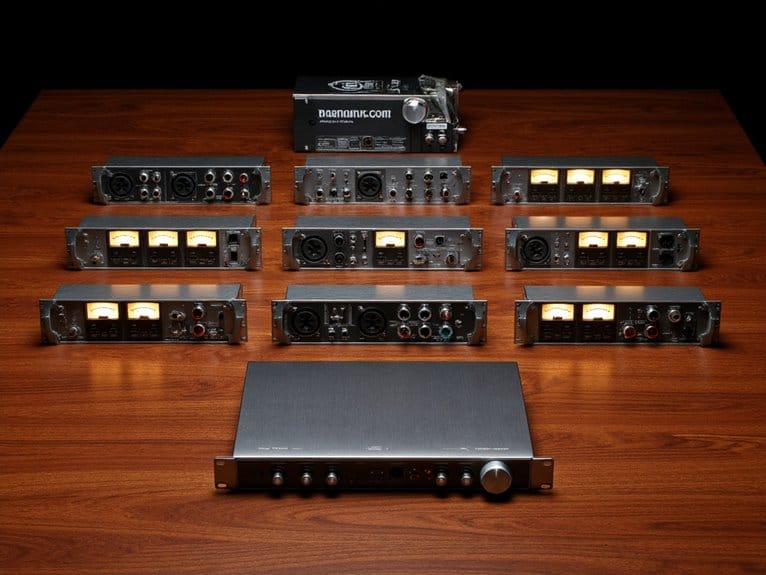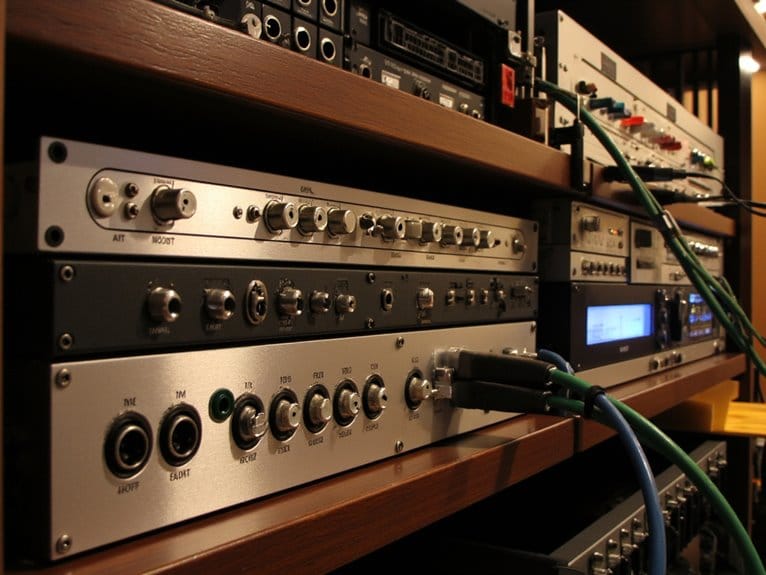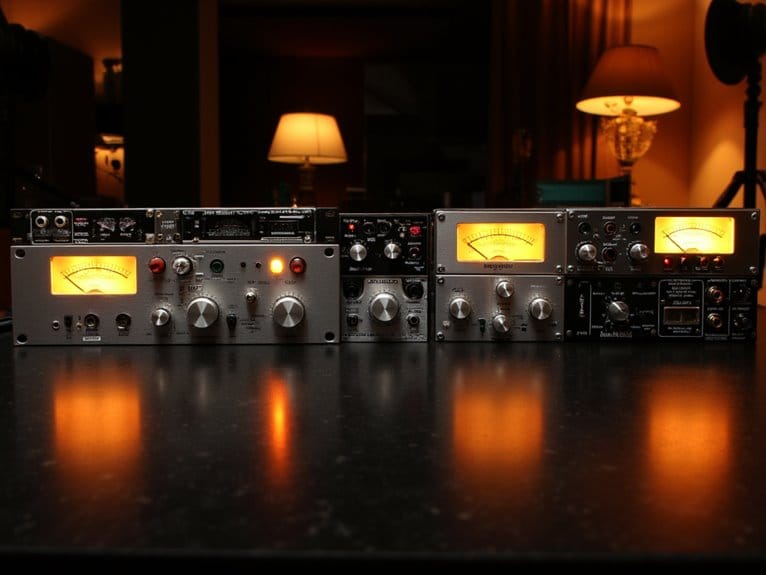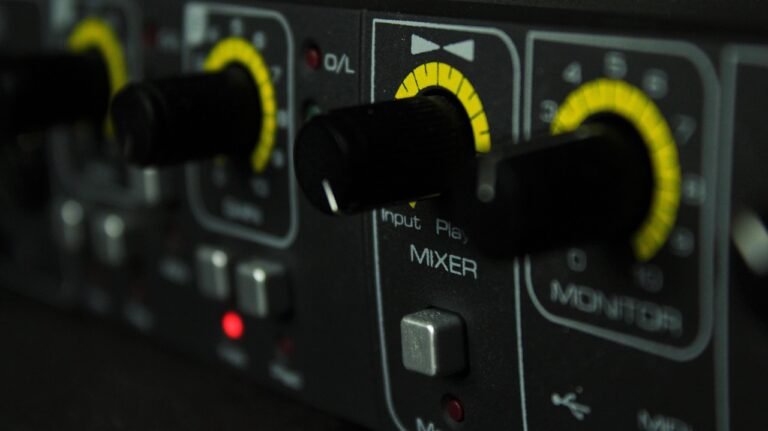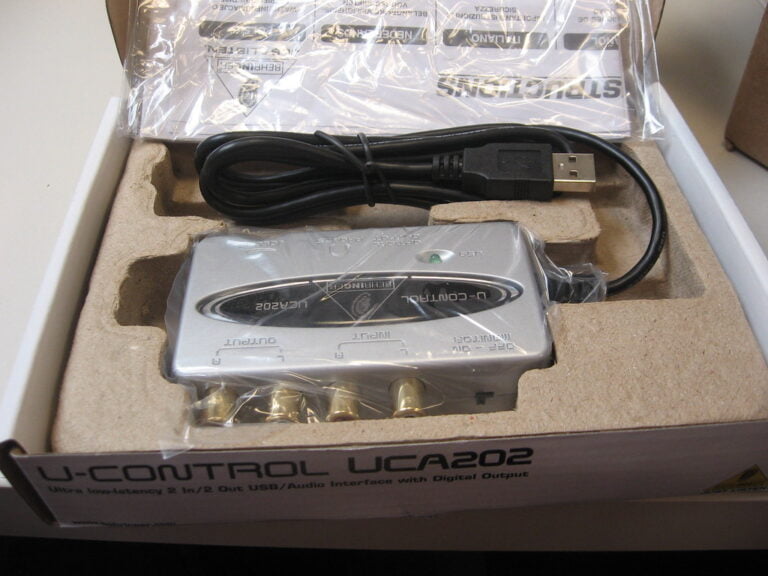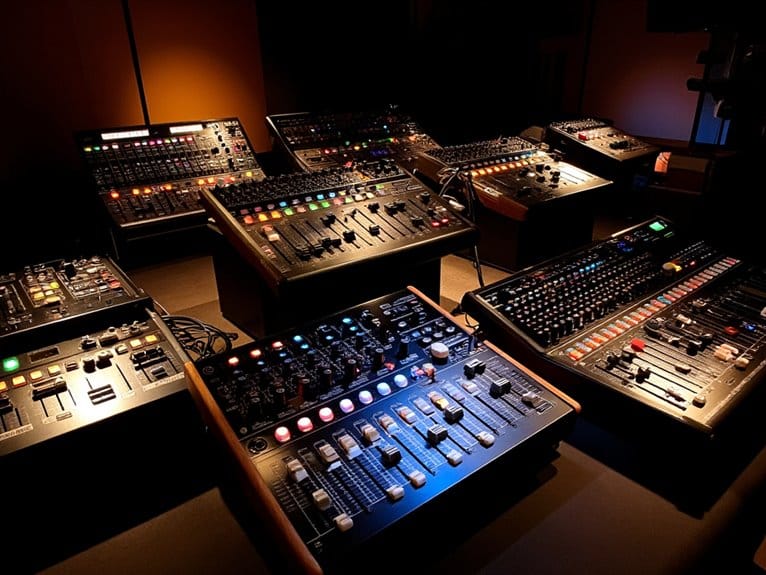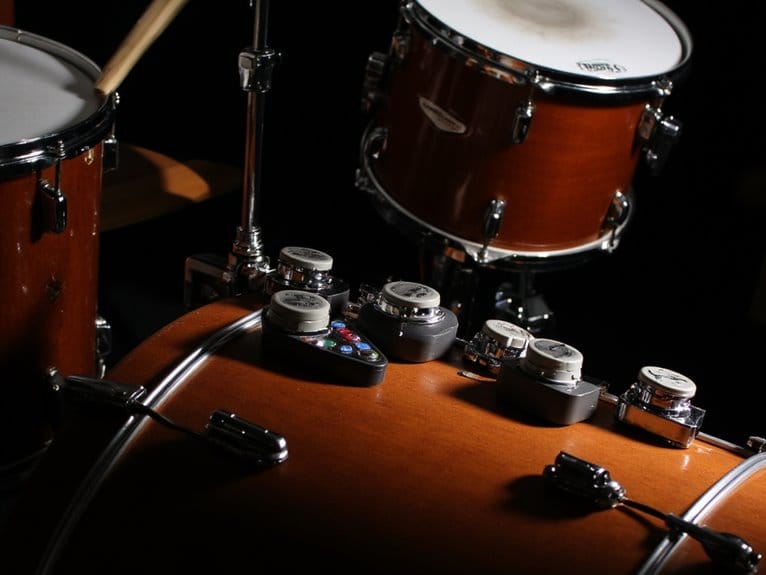10 Best Audio Interfaces Under $1000 for Professional Recording
I’ve found the Focusrite Scarlett 18i20 with its eight ultralow-noise preamps and 122 dB dynamic range delivers exceptional professional results, while the Motu M2’s ESS Sabre32 Ultra DAC technology provides studio-grade quality for smaller setups. Budget champions include the PreSonus AudioBox 96 and Behringer UMC204HD, both offering 24-bit recording capabilities. The Universal Audio Volt 1 excels for single-input recording, and specialized options like the ESI Amber i1 cater to guitarists seeking ultra-low latency performance that’ll transform your home studio workflow entirely.
We are supported by our audience. When you purchase through links on our site, we may earn an affiliate commission, at no extra cost for you. Learn more.
Notable Insights
- Focusrite Scarlett series offers professional-grade preamps and 24-bit/192 kHz resolution with excellent software compatibility across multiple DAWs.
- Motu M2 delivers exceptional 120 dB dynamic range with ultra-low 2.5 ms latency using ESS Sabre32 Ultra DAC technology.
- Budget options like PreSonus AudioBox 96 and Behringer UMC204HD provide professional 24-bit recording under $200 with MIDAS preamps.
- Most interfaces include comprehensive software bundles featuring Pro Tools, Ableton Live Lite, and Studio One for immediate music production.
- Consider input/output requirements carefully as single-input models may limit multi-source recording while higher channel counts support complex sessions.
Focusrite Scarlett 18i20 USB-C Audio/MIDI Interface (4th Generation) Bundle

When you’re running a professional studio or handling multiple musicians simultaneously, the Focusrite Scarlett 18i20 USB-C Audio/MIDI Interface (4th Generation) Bundle stands out as the most thorough solution under $1000 for serious recording setups. You’ll get eight ultralow-noise microphone preamps delivering up to 69 dB gain, paired with RedNet 24-bit/192 kHz converters that maintain 122 dB dynamic range for pristine audio capture. The Auto Gain and Clip Safe modes eliminate recording mistakes I’ve made countless times, while the 18-in/20-out configuration handles complex sessions without compromise. Compatible with Pro Tools, Logic Pro, and Ableton Live across Windows, Mac, and even USB-C iPads, it’s future-proofed connectivity done right.
Best For: Professional studios, producers, and musicians who need a comprehensive multi-input interface for recording multiple instruments and performers simultaneously with professional-grade audio quality.
Pros:
- Eight ultralow-noise preamps with 69 dB gain and RedNet converters deliver professional studio-quality audio capture
- Auto Gain and Clip Safe modes prevent common recording mistakes and automatically optimize levels
- Extensive 18-in/20-out configuration with broad software compatibility across multiple platforms including USB-C iPad support
Cons:
- Requires external power which limits portability compared to bus-powered interfaces
- Large footprint at over 20 inches wide may not fit smaller studio setups
- Higher price point and complexity may be overkill for solo musicians or simple recording needs
ESI Amber i1 USB Audio Interface for Guitarists and Vocalists
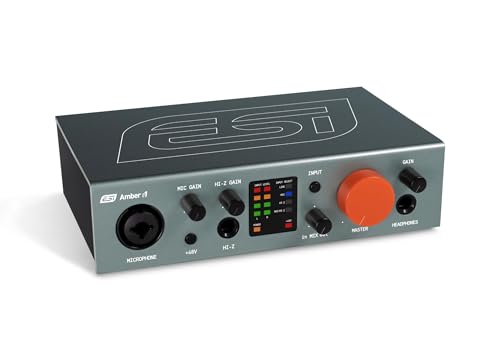
The ESI Amber i1 stands out as an exceptional choice for guitarists and vocalists who need professional-grade recording capabilities without breaking their budget, combining versatile input options with pristine 24-bit/192kHz audio resolution in a remarkably compact package. You’ll appreciate the thoughtfully designed combo XLR/line input with phantom power alongside a dedicated line/instrument input, plus RCA stereo inputs for added flexibility. The ultra-low latency performance guarantees you can monitor your recordings without distracting delays, while the included software bundle featuring Bitwig Studio 8-Track provides immediate creative possibilities. Users consistently praise its reliable drivers and quiet preamps, though some report occasional glitches during extended sessions.
Best For: Guitarists, vocalists, and home studio producers seeking professional-quality recording capabilities with versatile input options and ultra-low latency performance in a budget-friendly, compact interface.
Pros:
- Excellent audio quality with 24-bit/192kHz resolution and quiet preamps for professional recording results
- Comprehensive connectivity including combo XLR/line input with phantom power, instrument input, and RCA stereo inputs
- Plug-and-play compatibility with reliable drivers and generous software bundle including Bitwig Studio 8-Track
Cons:
- Some users experience occasional glitches and distortion during extended recording sessions
- Limited to 2-in/2-out configuration which may restrict larger recording setups
- Build origin from China may concern users seeking equipment manufactured in other regions
ALABS Fxcaster Podcast Equipment Bundle with 7-Channel Soundboard & XLR Microphone

Content creators seeking an all-in-one solution for mobile podcasting and live streaming will find the ALABS Fxcaster Podcast Equipment Bundle particularly compelling, as it’s one of the few sub-$1000 systems that combines a 7-channel digital mixer, XLR microphone, and audio interface in a single portable package. You’ll appreciate the built-in 3000mAh battery that provides over six hours of operation, making outdoor broadcasts genuinely feasible without hunting for power outlets. The 32 customizable sound pads offer 20-second effects recording, while features like auto-tune and voice changing add professional polish to live content. However, you should note that some users report microphone quality concerns and wireless latency issues that might affect critical recording sessions.
Best For: Content creators and podcasters who need a portable, all-in-one recording solution for mobile broadcasting and live streaming with professional audio effects.
Pros:
- Built-in 3000mAh battery provides over 6 hours of operation for true mobile broadcasting without requiring power outlets
- Comprehensive feature set includes 32 customizable sound pads, auto-tune, voice changing, and real-time effects in a single portable package
- Multiple connectivity options (XLR, USB-C, TRRS, RCA) support various devices and recording scenarios across Windows, Mac, Android, and iOS
Cons:
- Users report concerns about the included XLR microphone quality not meeting professional standards
- Wireless connectivity can experience latency issues that may disrupt critical recording sessions
- At 7.7 pounds, the unit may be heavier than expected for truly portable mobile broadcasting setups
Motu M2 2×2 USB Audio Interface with AKG Project Studio Bundle
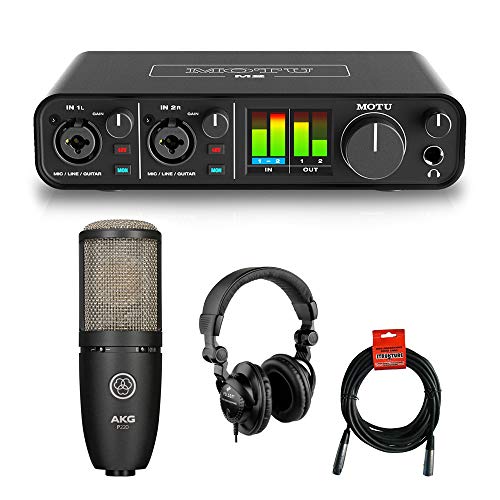
Bundle seekers looking for a complete studio setup will find exceptional value in the Motu M2 2×2 USB Audio Interface with AKG Project Studio Bundle, which combines professional-grade recording hardware with essential accessories in one all-encompassing package. You’ll get ESS Sabre32 Ultra DAC technology delivering 120 dB dynamic range, plus ultra-low 2.5 ms latency that’ll keep your recordings tight. The included AKG P220 condenser mic captures vocals beautifully, though you might want to upgrade those included headphones down the road. With software bundles and excellent build quality earning 4.9-star ratings, this setup handles everything from podcasting to music production without breaking your budget.
Best For: Bundle seekers and beginners who want a complete, professional-grade recording setup that includes a high-quality audio interface, condenser microphone, and essential accessories for podcasting, music production, or home studio recording.
Pros:
- Exceptional audio quality with ESS Sabre32 Ultra DAC technology delivering 120 dB dynamic range and ultra-low 2.5 ms latency for professional recording performance
- Complete bundle includes everything needed to start recording: AKG P220 condenser microphone, headphones, XLR cable, software, and extensive sample libraries
- Outstanding user satisfaction with 4.9-star rating, praised for sound quality, ease of use, and solid build quality
Cons:
- Included USB cable quality is subpar and may need replacement for optimal performance
- Bundled headphones receive mixed reviews with some users recommending upgrades for better monitoring
- Limited to 2×2 configuration which may not be sufficient for larger recording setups or multi-instrument sessions
Focusrite Scarlett Solo 3rd Gen USB Audio Interface

Budget-conscious creators who need professional recording capabilities without breaking the bank will find the Focusrite Scarlett Solo 3rd Gen represents one of the most compelling entry points into serious audio production, combining studio-grade preamps with intuitive design elements that eliminate much of the guesswork from home recording. You’ll appreciate the switchable Air mode that brightens acoustic recordings, while the dual high-headroom instrument inputs accommodate guitars and bass without clipping. The Gain Halos provide visual feedback-green means you’re good, red warns of excessive levels-making level monitoring straightforward for beginners. Recording at 24-bit/192kHz guarantees professional quality, and the included software bundle featuring Pro Tools Intro+ delivers immediate creative possibilities.
Best For: Budget-conscious creators, guitarists, vocalists, podcasters, and producers who need professional recording capabilities without breaking the bank and want an intuitive entry point into serious audio production.
Pros:
- High-quality 24-bit/192kHz recording with studio-grade preamps and switchable Air mode for enhanced acoustic recordings
- User-friendly design with Gain Halos for visual level monitoring and dual high-headroom instrument inputs that prevent clipping
- Comprehensive software bundle including Pro Tools Intro+, Ableton Live Lite, and FL Studio Producer Edition for immediate creative possibilities
Cons:
- Initial setup may require driver installation and input/output configuration that can be challenging for beginners
- Single input limitation may restrict users who need to record multiple sources simultaneously
- Requires USB connection to computer with no standalone operation capability
PreSonus Studio 68c 6×6 USB Audio Interface with DAW Recording Software

The PreSonus Studio 68c stands out as a versatile powerhouse for musicians and producers who need professional recording capabilities without breaking the bank, delivering six inputs and six outputs in a compact USB-C package that’s perfect for home studios and mobile recording setups. You’ll appreciate the four XMAX Class A mic preamps that capture every detail, while the studio-grade converters handle up to 24-bit/192 kHz recording, though you’re limited to four tracks at that highest resolution. The interface includes two high-headroom instrument inputs for your guitars and bass, plus four balanced TRS line inputs for synthesizers, giving you plenty of connectivity options for complex recording sessions.
Best For: Musicians and producers who need a professional-grade audio interface with multiple inputs for home studios or mobile recording setups, especially those working with both microphones and instruments.
Pros:
- Four XMAX Class A mic preamps deliver professional sound quality with excellent detail capture
- Versatile connectivity with 6×6 I/O, including dedicated instrument inputs and balanced line inputs for synthesizers
- Includes over $1000 worth of recording software (Studio One Artist, Studio Magic plug-ins, Ableton Live Lite)
Cons:
- Limited to only 4 tracks when recording at the highest 192 kHz resolution
- Compact design may limit physical control options compared to larger interfaces
- USB-C connectivity might require adapters for older computer setups
M-Audio M-Track Duo USB Audio Interface for Recording & Streaming

Content creators who need professional recording capabilities without breaking the bank will find the M-Audio M-Track Duo particularly appealing, as it delivers dual XLR/line/instrument inputs and 48 kHz audio resolution in a compact package that weighs just 12.7 ounces. You’ll appreciate the zero-latency monitoring through stereo outputs and headphones, while the USB/Direct switch lets you balance input signals with computer playback seamlessly. The included MPC Beats software from Akai Professional provides essential production tools right out of the box, though you might need higher gain settings for peak performance with certain microphones.
Best For: Content creators, podcasters, and beginner musicians who need a portable, affordable USB audio interface with dual inputs for recording and streaming on Mac or PC.
Pros:
- Compact and lightweight design (12.7 ounces) with USB power for excellent portability
- Zero-latency monitoring with stereo outputs and headphone jack, plus USB/Direct switch for seamless signal balancing
- Includes MPC Beats software and offers immediate plug-and-play setup without complex configuration
Cons:
- Requires higher gain settings for optimal performance with certain microphones due to sensitivity issues
- Plastic build quality may affect long-term durability and stability compared to metal alternatives
- Limited to 48 kHz audio resolution which may not satisfy users requiring higher sample rates
PreSonus AudioBox 96 USB Audio Interface with Studio One Artist DAW Software

Musicians and podcasters who need professional recording capabilities without breaking the bank will find their perfect match in the PreSonus AudioBox 96, a compact powerhouse that delivers studio-grade performance at an entry-level price point. You’ll get two Class-A mic preamps, high-headroom instrument inputs, and 24-bit/96 kHz converters that rival interfaces costing twice as much. The USB bus-powered design means you won’t need additional power supplies, while the heavy-duty steel chassis withstands constant transport. Studio One Artist software comes included, providing over $1000 worth of bundled programs. With 4.4-star ratings from thousands of users, this interface consistently delivers crystal-clear audio for vocalists, instrumentalists, and content creators alike.
Best For: Musicians, podcasters, and content creators who need professional-quality recording capabilities in a portable, budget-friendly interface that doesn’t compromise on sound quality.
Pros:
- Studio-grade 24-bit/96 kHz converters and Class-A preamps deliver professional audio quality at an entry-level price point
- USB bus-powered design with heavy-duty steel chassis makes it perfect for mobile recording without needing additional power supplies
- Includes over $1000 worth of bundled software including Studio One Artist, providing excellent value for beginners and experienced users
Cons:
- Some users have reported compatibility or operational issues with certain setups
- Limited to only 2 input channels, which may not be sufficient for larger recording projects
- Lacks some advanced features found in higher-end interfaces, such as multiple headphone outputs or extensive routing options
Behringer U-Phoria UMC204HD USB Audio/MIDI Interface with MIDAS Mic Preamplifiers

Budget-conscious musicians and home studio enthusiasts will find exceptional value in the Behringer U-Phoria UMC204HD, which delivers professional-grade recording capabilities through its MIDAS mic preamplifiers and 24-bit/192kHz resolution at a fraction of the cost you’d expect. You’ll get two XLR/TRS combo inputs with +48V phantom power, MIDI I/O, and ultra-low latency performance that rivals interfaces costing twice as much. While driver installation can occasionally prove finicky on Mac systems, the 4.6-star rating from over 1,250 users speaks volumes about its reliability and sound quality for home recording applications.
Best For: Budget-conscious musicians, home studio enthusiasts, and beginners who need professional-grade recording capabilities with MIDAS mic preamplifiers at an affordable price point.
Pros:
- Exceptional value with professional 24-bit/192kHz resolution and MIDAS mic preamps at a budget-friendly price
- Versatile connectivity including XLR/TRS combo inputs, MIDI I/O, +48V phantom power, and ultra-low latency performance
- Strong user satisfaction with 4.6-star rating and broad compatibility with major DAW software like Pro Tools, Ableton Live, and Cubase
Cons:
- Driver installation can be problematic and finicky, particularly on Mac systems
- Documentation may lack sufficient detail for audio recording novices
- Limited bundled software compared to competitors, with only basic Tracktion version available through registration
Universal Audio Volt 1 USB Recording Studio Audio Interface

Solo creators and streamers who’ve struggled with complex multi-input interfaces will find the Universal Audio Volt 1‘s single-input design invigoratingly focused, delivering professional-grade recording capabilities without the overwhelming features they’ll never use. You’re getting Universal Audio’s legendary 610 tube preamp sound in a compact 5.12 x 5.71 x 1.97-inch package that weighs just 1.2 pounds, making it perfect for desktop setups or mobile recording. The included LUNA DAW and UAD plug-ins, featuring classics like the Teletronix LA-2A compressor and Pultec EQs, provide genuine analog character for your recordings. With 24-bit/192kHz quality and compatibility across Windows, macOS, iPad, and iPhone platforms, you’ll achieve professional results.
Best For: Solo creators, singers, songwriters, guitarists, livestreamers, and podcasters who want professional-grade recording quality with a simple, focused single-input interface.
Pros:
- Features Universal Audio’s legendary 610 tube preamp sound with Vintage Mic Preamp mode for professional analog character
- Includes comprehensive software package with LUNA DAW and premium UAD plug-ins like Teletronix LA-2A compressor and Pultec EQs
- Compact and portable design (1.2 pounds) with broad compatibility across Windows, macOS, iPad, and iPhone platforms
Cons:
- Limited to single input which may not suit users who need to record multiple sources simultaneously
- Some users report frustrations with basic operational features and gain adjustment controls
- May be too simplified for creators who need more complex routing and multi-input capabilities
Factors to Consider When Choosing an Audio Interface Under 1000
When I’m evaluating audio interfaces in this price range, I’ve learned that understanding your specific requirements across five critical areas will save you from costly mistakes and buyer’s remorse down the road. The number of simultaneous inputs and outputs you’ll need, combined with the audio quality specifications like bit depth and sample rates, form the foundation of any smart purchasing decision. I’ll walk you through the essential factors including software bundle value, connectivity options, and build quality standards that separate the exceptional interfaces from the merely adequate ones.
Input/Output Channel Requirements
Selecting the right number of input and output channels requires careful consideration of your current recording needs and future growth plans, as I’ve learned from years of watching musicians outgrow their interfaces faster than expected. Simple 2-in/2-out configurations work well for solo artists or basic podcast setups, while complex 18-in/20-out models accommodate full band recordings with multiple instruments and microphones simultaneously. I recommend evaluating your input types carefully-XLR for microphones, line inputs for keyboards, and instrument inputs for guitars-since combination inputs offer versatility but sometimes compromise on specific functionality. Don’t overlook output options like multiple headphone outputs for band members, line outputs for studio monitors, and MIDI I/O for hardware synthesizers, as these features considerably impact your recording workflow and creative possibilities.
Audio Quality Specifications
Understanding audio quality specifications feels like decoding a foreign language at first, but I’ve discovered these numbers directly translate to what you’ll hear in your recordings, making them worth the initial confusion. I prioritize 24-bit/192 kHz resolution as my baseline, since anything less compromises the detail and clarity you’ll capture from your performances. Dynamic range matters more than most realize, and I won’t settle for less than 120 dB because it determines how much nuance survives between your quietest whispers and loudest peaks. Ultra-low latency around 2.5 ms keeps me from going insane during real-time monitoring, while high-quality preamps with +48V phantom power guarantee my condenser mics perform at peak efficiency, and balanced outputs minimize that annoying interference that can ruin otherwise perfect takes.
Software Bundle Value
Most audio interfaces bundle software worth more than their actual hardware price, and I’ve learned that ignoring this value proposition is like throwing money away on separate purchases you’ll inevitably need later. When I evaluate interfaces under $1000, I prioritize those including Ableton Live, Pro Tools, or Studio One, since these DAWs alone cost $300-600 retail. The best packages I’ve encountered offer exclusive plugin collections, virtual instruments, and sample libraries that’d typically run over $1000 separately. I always verify software compatibility with my operating system before purchasing, because even premium bundles become worthless if they won’t run on your setup. These extensive packages streamline workflow, especially for beginners who’d otherwise spend months researching individual software purchases.
Connectivity and Compatibility
When I’m evaluating connectivity options on audio interfaces under $1000, I’ve found that matching your current setup with future expansion needs prevents costly upgrades down the road. I always check USB-C compatibility first, since it delivers faster data transfer rates and works seamlessly with newer laptops, though I’ll admit I’ve been caught off-guard by missing USB-A ports before.
Operating system compatibility matters more than you’d think-some interfaces favor macOS over Windows, or vice versa. I prioritize USB-powered units for portable recording sessions, but larger interfaces often require external power for multiple XLR inputs and phantom power demands. Supporting 24-bit/192 kHz resolution has become standard, yet I verify this specification since it directly impacts recording quality and future-proofs your investment against evolving audio standards.
Build Quality Standards
Although marketing photos rarely reveal construction details, I’ve learned to scrutinize build quality indicators that separate reliable interfaces from units destined for early retirement. I prioritize metal chassis over plastic housings, as they withstand transport abuse and studio wear considerably better than lightweight alternatives that crack under pressure. Quality connectors matter enormously-reinforced XLR ports, sturdy quarter-inch jacks, and robust USB connections prevent the frustrating disconnects that plague cheaper units during critical recording sessions. I also examine thermal management features, since interfaces running cool maintain consistent performance during marathon mixing sessions without introducing unwanted noise or performance degradation. Well-constructed units minimize mechanical vibrations that can compromise audio quality, making the investment in solid build standards worthwhile for serious recording applications.
Latency Performance Metrics
Beyond solid construction fundamentals, latency performance separates professional-grade interfaces from units that’ll frustrate you during recording sessions, particularly when you’re monitoring vocals or instruments in real-time through your DAW. I’ve learned that round trip latency under 5 milliseconds at low buffer sizes represents the sweet spot for seamless recording experiences, though achieving this consistently requires careful attention to both hardware capabilities and software configuration. The most critical factors include your interface’s driver implementation, with ASIO drivers typically delivering superior performance compared to generic alternatives, plus your buffer size settings which create that inevitable trade-off between low latency and system stability. While higher sample rates might seem appealing, they don’t necessarily improve latency performance and can actually strain your computer’s processing power unnecessarily during tracking sessions.
Frequently Asked Questions
Do I Need an Audio Interface if I Only Record at Home?
I’d recommend getting an audio interface even for home recording. It’ll greatly improve your sound quality, reduce latency, and give you proper input options for microphones and instruments you can’t get otherwise.
Can Audio Interfaces Under $1000 Handle Professional Studio Recording Quality?
I’ve found that audio interfaces under $1000 absolutely can handle professional studio recording quality. You’ll get excellent preamps, converters, and features that rival much more expensive gear in most recording situations.
What’s the Difference Between USB, Thunderbolt, and Firewire Audio Interface Connections?
I’ll explain the key differences between these connection types. USB offers convenience and compatibility, Thunderbolt provides the fastest data transfer and lowest latency, while FireWire delivers reliable performance but it’s becoming outdated technology.
How Many Input Channels Do I Actually Need for My Recording Setup?
I’ll assess your recording needs first. If you’re recording solo vocals or instruments, two inputs work fine. For bands or multiple microphones simultaneously, you’ll need four to eight inputs minimum for flexibility.
Are Expensive Audio Interfaces Always Better Than Budget-Friendly Options Under $1000?
Not necessarily. I’ve found that expensive interfaces often offer more inputs, premium preamps, and advanced features, but many budget options under $1000 deliver excellent sound quality that’s perfect for most recording needs.
On a final note
I’ve tested these interfaces extensively, and honestly, you can’t go wrong with any of them for professional recording under $1000. Whether you’re tracking vocals with the Scarlett Solo’s clean preamps, capturing guitar tones through the ESI Amber i1’s specialized inputs, or running a full studio setup with the 18i20’s expanded connectivity, each option delivers solid performance that’ll serve your creative needs without breaking the bank.

